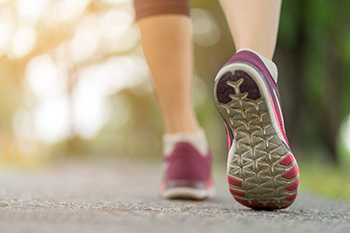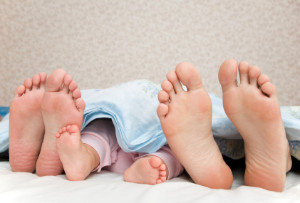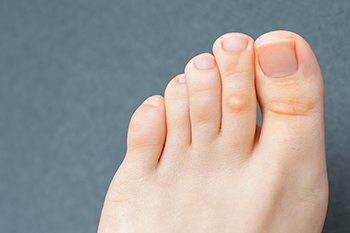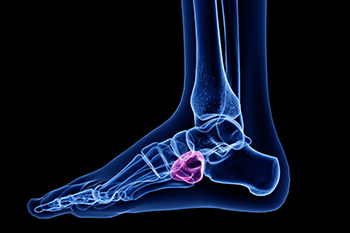Items filtered by date: December 2022
Causes and Effects of Foot Drop

Foot drop is a condition that makes it difficult to lift the foot high enough to clear the ground when you take a step. As a result, people with foot drop may appear to be high-stepping or marching when they walk. It also may cause you to slap your foot down on the ground with each step. In some cases, the top of the foot or the toes may feel numb. Foot drop is not a disease, but is generally caused by a neurological, muscular, or anatomical problem. The symptoms indicate a weakness or paralysis in the muscles that lift the foot. There are a number of underlying conditions, such as muscular dystrophy, that may be at the root of the problem. Foot drop can be a temporary condition, but if it becomes permanent more advanced diagnostic methods may be recommended. A podiatrist can conduct a number of imaging tests to determine the cause of foot drop. In addition, an ankle foot orthosis may be prescribed to hold the foot in place. Also, electrical nerve stimulation is sometimes helpful. Please consult a podiatrist for more information.
If you have any concerns about your feet, contact Dr. John P. Beaupied from Palos Podiatry. Our doctor can provide the care you need to keep you pain-free and on your feet.
Biomechanics in Podiatry
Podiatric biomechanics is a particular sector of specialty podiatry with licensed practitioners who are trained to diagnose and treat conditions affecting the foot, ankle and lower leg. Biomechanics deals with the forces that act against the body, causing an interference with the biological structures. It focuses on the movement of the ankle, the foot and the forces that interact with them.
A History of Biomechanics
- Biomechanics dates back to the BC era in Egypt where evidence of professional foot care has been recorded.
- In 1974, biomechanics gained a higher profile from the studies of Merton Root, who claimed that by changing or controlling the forces between the ankle and the foot, corrections or conditions could be implemented to gain strength and coordination in the area.
Modern technological improvements are based on past theories and therapeutic processes that provide a better understanding of podiatric concepts for biomechanics. Computers can provide accurate information about the forces and patterns of the feet and lower legs.
Understanding biomechanics of the feet can help improve and eliminate pain, stopping further stress to the foot.
If you have any questions please feel free to contact our office located in Palos Heights, IL . We offer the newest diagnostic and treatment technologies for all your foot and ankle needs.
When to Worry About a Child’s Foot Pain

Early intervention is key to halting chronic foot problems in children. Issues that are common with children’s feet include flat feet, which describes the appearance of a foot that does not have a well-developed arch and the foot lays flat against the floor. While there are usually no symptoms of flat feet in kids, some children may complain of cramping, pain, and tenderness in the foot or leg. They might limp or exhibit an aversion to athletic activities and walking because they say their legs and feet get tired. It is important that parents do not automatically attribute a child’s foot pain to growing pains as it can be more serious. It is suggested that if your child says or shows they feel pain in their feet or legs, a podiatrist be consulted to do a thorough examination of the feet and rule out anything serious or structural abnormalities that might be helped with simple intervention techniques.
Making sure that your children maintain good foot health is very important as they grow. If you have any questions, contact Dr. John P. Beaupied of Palos Podiatry. Our doctor can provide the care you need to keep you pain-free and on your feet.
Keeping Children's Feet Healthy
Having healthy feet during childhood can help prevent medical problems later in life, namely in the back and legs. As children grow, their feet require different types of care. Here are some things to consider...
Although babies do not walk yet, it is still very important to take care of their feet.
Avoid putting tight shoes or socks on his or her feet.
Allow the baby to stretch and kick his or her feet to feel comfortable.
As a toddler, kids are now on the move and begin to develop differently. At this age, toddlers are getting a feel for walking, so don’t be alarmed if your toddler is unsteady or ‘walks funny’.
As your child gets older, it is important to teach them how to take care of their feet.
Show them proper hygiene to prevent infections such as fungus.
Be watchful for any pain or injury.
Have all injuries checked by a doctor as soon as possible.
Comfortable, protective shoes should always be worn, especially at play.
If you have any questions please feel free to contact our office located in Palos Heights, IL . We offer the newest diagnostic and treatment technologies for all your foot and ankle needs.
How to Get Rid of Foot Corns
 When the skin on the feet is exposed to friction or pressure, circles of hard, thick skin, called corns can develop. These usually come on the sides and tops of the toes or between the toes. Wearing shoes without socks and the rubbing this can cause on feet while walking, running, or standing for long periods of time can contribute to the development of corns. Proper foot care goes a long way in preventing corns. Washing, drying, and using moisturizer on the feet each day is imperative. Wear shoes that are comfortable and fit well. If you get a corn, you can soak your feet in warm water for about 10 minutes and then use a pumice stone to gently massage it to help remove dead skin cells and try to alleviate pain. Once this is done, it might help to put a cotton ball soaked in castor oil over the corn and secure it with a bandage. Doing this each day may help the corn heal. If using such methods does not resolve the issue, make an appointment with a podiatrist who can offer you additional treatment options.
When the skin on the feet is exposed to friction or pressure, circles of hard, thick skin, called corns can develop. These usually come on the sides and tops of the toes or between the toes. Wearing shoes without socks and the rubbing this can cause on feet while walking, running, or standing for long periods of time can contribute to the development of corns. Proper foot care goes a long way in preventing corns. Washing, drying, and using moisturizer on the feet each day is imperative. Wear shoes that are comfortable and fit well. If you get a corn, you can soak your feet in warm water for about 10 minutes and then use a pumice stone to gently massage it to help remove dead skin cells and try to alleviate pain. Once this is done, it might help to put a cotton ball soaked in castor oil over the corn and secure it with a bandage. Doing this each day may help the corn heal. If using such methods does not resolve the issue, make an appointment with a podiatrist who can offer you additional treatment options.
If you have any concerns regarding your feet and ankles, contact Dr. John P. Beaupied of Palos Podiatry. Our doctor will treat your foot and ankle needs.
Corns: What Are They? and How Do You Get Rid of Them?
Corns can be described as areas of the skin that have thickened to the point of becoming painful or irritating. They are often layers and layers of the skin that have become dry and rough, and are normally smaller than calluses.
Ways to Prevent Corns
There are many ways to get rid of painful corns such as wearing:
- Well-fitting socks
- Comfortable shoes that are not tight around your foot
- Shoes that offer support
Treating Corns
Treatment of corns involves removing the dead skin that has built up in the specific area of the foot. Consult with Our doctor to determine the best treatment option for your case of corns.
If you have any questions please feel free to contact our office located in Palos Heights, IL . We offer the newest diagnostic and treatment technologies for all your foot and ankle needs.
Certain People May Be Prone to Getting Cuboid Syndrome

There are seven tarsal bones in each foot, and the cuboid bone is one of them. An injury can cause pain on the outside of the foot when the cuboid bone is affected, which can result in cuboid syndrome. Some patients feel pain in the middle of their foot, or on the bottom of the fourth and fifth toes. This condition can occur when the bones in the center of the foot become partially dislocated from gradual overuse, or from a sudden injury. It is a common injury among ballet dancers, as a result of this style of dancing. Patients who have feet that turn inward may have an increased risk of developing cuboid syndrome, in addition to wearing shoes that do not fit correctly. People who run on uneven surfaces may get this condition, and warming up or cooling down inadequately may increase the risk of having cuboid syndrome. Effective treatment begins with temporarily stopping the activity that caused the condition, and frequently elevating the affected foot may reduce the swelling. If you have this ailment, please consult with a podiatrist who can accurately diagnose and treat cuboid syndrome.
Cuboid syndrome, also known as cuboid subluxation, occurs when the joints and ligaments near the cuboid bone in the foot become torn. If you have cuboid syndrome, consult with Dr. John P. Beaupied from Palos Podiatry. Our doctor will assess your condition and provide you with quality foot and ankle treatment.
Cuboid syndrome is a common cause of lateral foot pain, which is pain on the outside of the foot. The condition may happen suddenly due to an ankle sprain, or it may develop slowly overtime from repetitive tension through the bone and surrounding structures.
Causes
The most common causes of cuboid syndrome include:
- Injury – The most common cause of this ailment is an ankle sprain.
- Repetitive Strain – Tension placed through the peroneus longus muscle from repetitive activities such as jumping and running may cause excessive traction on the bone causing it to sublux.
- Altered Foot Biomechanics – Most people suffering from cuboid subluxation have flat feet.
Symptoms
A common symptom of cuboid syndrome is pain along the outside of the foot which can be felt in the ankle and toes. This pain may create walking difficulties and may cause those with the condition to walk with a limp.
Diagnosis
Diagnosis of cuboid syndrome is often difficult, and it is often misdiagnosed. X-rays, MRIs and CT scans often fail to properly show the cuboid subluxation. Although there isn’t a specific test used to diagnose cuboid syndrome, your podiatrist will usually check if pain is felt while pressing firmly on the cuboid bone of your foot.
Treatment
Just as the range of causes varies widely, so do treatments. Some more common treatments are ice therapy, rest, exercise, taping, and orthotics.
If you have any questions, please feel free to contact our office located in Palos Heights, IL . We offer the newest diagnostic and treatment technologies for all your foot care needs.




